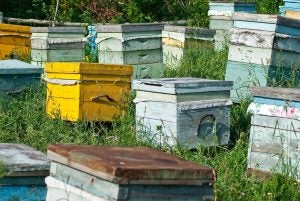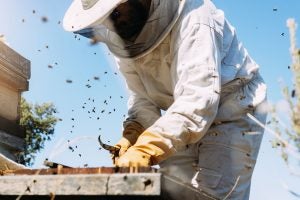Some people argue that an increase in insecticide use (both organic and synthetic) and a much-publicized Colony Collapse Disorder issue have caused honey bees to become endangered. There are numerous organizations dedicated to “saving the bees,” and many of them have targeted farmers as major culprits in the demise of the honey bee population. On the other hand, there are fears that agriculture itself is suffering because of bee loss — after all, there are 20,000 species of bees, of which 4,000 contribute to pollination. Although the success and sustainability of the insect is a serious issue and has caused panic, the news stories haven’t been all they seem.
It’s important to understand the broader aspects to whether honey bees are endangered and what factors go into how their health is examined and the trends that we’re seeing.
The truth is that there are eight species of bees that have been placed on the endangered list: different species of Hawaiian yellow-faced bees in 2016 and, more recently, the Rusty patched bumble bee. Honey bees, and other species, are not on this list, nor have they ever been. The causes for the loss of the aforementioned endangered bee species are widely believed to be due to habitat loss, natural disasters, and invasive species.
Honey bee populations
Although, the honey bee isn’t on the endangered list, many are still under the impression that they soon will go extinct. Since this species is known for its role in agriculture, the blame is often placed on the ag industry for Colony Collapse Disorder, specifically related to pesticide use. This blame is misguided, however, according to many reports.
An extensive analysis done by The Washington Post and published in 2017 show bee numbers sitting at close to historical highs. The research showed that since 2006, when CCD was identified, the number of honeybee colonies has risen, from 2.4 million that year to 2.7 million in 2014.
While some loss in individual bee numbers over winter months is expected, The Washington Post’s report came on the heels of another major announcement related to Colony Collapse Disorder: The rate of loss among honey bee colonies reached its lowest point in years.

Data from the U.S. Department of Agriculture’s National Agricultural Statistics Service point to general strengths in honey bee colonies: “In 2017, the United States had 2.88 million honey bee colonies, down 12 percent from the record high 3.28 million colonies in 2012, but down less than 1 percent from 2007,” the agency said.
Adding context to the data compiled independently from The Washington Post and the USDA, the American Council on Science and Health has stated: “CCD, which lasted for about 3-5 years, is a sudden phenomenon in which the majority of worker bees mysteriously disappear. That problem, which showed up most dramatically in California, abated by 2011.”
Part of the reason public awareness of Colony Collapse Disorder was amplified was the start and alarming number of hives that were not surviving the winter in the mid- to late-2000s — a number that hovered around 60 percent.
According to the U.S. Environmental Protection Agency, “The number of hives that do not survive over the winter months — the overall indicator for bee health — has maintained an average of about 28.7 percent since 2006-2007 but dropped to 23.1 percent for the 2014-2015 winter. While winter losses remain somewhat high, the number of those losses attributed to CCD has dropped from roughly 60 percent of total hives lost in 2008 to 31.1 percent in 2013.”
Since that time, CCD is not even mentioned as a factor by the EPA in winter hive losses. There do not appear to be enduring declines in colony numbers.
Chronic bee paralysis
A growing threat to bees in some regions is chronic bee paralysis, a disease caused by a virus known as chronic bee paralysis virus (CBPV), where infected bees die within a week. This leads to piles of dead bees just outside honey bee hives and whole colonies are frequently lost to the disease.
Chronic bee paralysis symptoms include abnormal trembling, an inability to fly, and the development of shiny, hairless abdomens.
Researchers in the United Kingdom found that the number of honey bee colonies affected with chronic bee paralysis rose exponentially between 2007 and 2017. Data collected from visits to over 24,000 beekeepers confirmed that while chronic bee paralysis was recorded only in Lincolnshire in 2007, a decade later it was present in 39 of 47 English and six of eight Welsh counties. The scientists also found that clusters of chronic bee paralysis, where disease cases are found close together, were becoming more frequent.
Professor Giles Budge of Newcastle University, the lead author of the study Chronic bee paralysis as a serious emerging threat to honey bees, said: “We do not yet know why colonies of bee farmers are at increased risk from this damaging disease, but many management practices are known to differ significantly between amateur and professional apiarists.”
Budge’s study investigated whether disease risk was associated with honey bee queen imports. Honey bee queens head up honey bee colonies and beekeepers use imported honey bee queens to replenish their stocks. The scientists used data from 130,000 honey bee imports from 25 countries to show for the first time that the disease was nearly twice as likely in apiaries owned by beekeepers who imported honey bees.
The monoculture argument
Bee health is often discussed in conjunction with agricultural monocultures. This happens for two reasons:
- Monocultures are believed to be hubs for the overuse of applications of herbicides, insecticides, fungicides, and other pesticide products.
- Large agricultural operations, particularly in the West all the way to California, often have bees brought in on trucks to help pollinate crops.
To the first point, “overuse” is going to be a matter of perspective. In general, when a farmer is dealing with that kind of scale (often in the thousands of acres), overuse of crop protection chemicals would mean they are paying too much money out of their pockets and it means potential damage to their land. So overuse doesn’t typically happen. Some experts argue that runoff is more likely to occur on a residential level, where homeowners may not realize that minuscule amounts of an herbicide that is needed to be effective in their driveways and around their pools.

The monoculture argument does have more validity when those huge swaths of single-type crops that are free of weeds and flowering plants don’t offer honey bees and other pollinators the opportunity to feed. To this end, many conservation efforts center around creating pollinator buffer zones and conservation easements, to help give migrating pollinators the opportunity to sustain themselves better. Monocultures are still common in parts of the Midwest and in California, but crop rotations and governmental and nonprofit initiatives are doing well to help on this front.
Regarding the trucking of bee hives to various parts of the country, that’s done because honey bees are crucial to flowering fruits and nuts, such as almonds, cherries, apples, raspberries, and avocados. The concerns that arise across those miles traveled are that there will be too much stress on the bees in their hives, thus causing deaths or decreases in production and mobility, or that a crash or theft can completely wipe out several hives at once.
In any instance of monoculture, how one views the food system is going to be a deeply personal one and will shape their opinions of such a system: It’s a trade-off of access to an abundant and affordable food supply, or of adopting a less efficient and likely lower-yielding agricultural industry process.
The media and honey bees
Many in the media frequently use scare tactics to convince readers that there is still a major issue with hive health.
On this topic, Grainews interviewed Dr. Ieuan Evans, an expert plant pathologist and horticulturalist. Evans said, “The furor over Colony Collapse Disorder has largely been blamed on pesticides; bees bringing the chemical home to the brood. When colonies die out or show very poor vigor or honey production, the easiest target to blame is not these natural causes but pesticides, in particular, insecticides. However, more likely, it is due to a combination of bee diseases such as foulbrood and chalkbrood, pests such as Varroa and Acarina mites and hive beetles.”

When it comes to pesticides, experts aren’t convinced this is a cause for concern. The American Council on Science and Health noted that, “As for neonicotinoids, the controversial class of insecticides commonly applied as a seed coating, [former Oregon State University professor Michael] Burgett says that despite over a decade of study, it’s still yet to be proven that they’re playing a significant role in honeybee deaths.” Evans agreed, “In general producers have good relationships with the beekeepers that place beehives on their lands. While we are fully aware that insecticides will kill bees, farmers growing agricultural or horticultural crops are generally cognizant of the beehives in or near their cropland. Bee kills are avoided when farmers are informed. Communication is key in reducing bee deaths due to pesticide application.”
Since honey bees aren’t native to the Americas, beekeepers and farmers are helping to preserve the honey bee population, despite other wild bee species experiencing loss. Both the beekeeper and farmer must know how to manage hives, what their health hazards are, and ensure they have access to plenty of nutrients and water.
What can you do to help?
Regardless of which species are endangered, there are practices people both in and out of the agricultural industry can do to help preserve the much-needed pollinators.
“Producers must continue to use good bee-safe management tools and beekeepers need to control the pest infestations in their hives and to collaborate with responsible farmers in order to successfully maintain and profit from their industry. Honey producers together with their bees can then help optimize specific crop production where and when honeybees are needed,” Evans said.
Agricultural companies such as BASF regularly send out pollinator-friendly plants to those who request them, while Syngenta does awareness roadtrips during National Pollinator Week. Elsewhere, webinars and sponsorships are being given to promote bee efforts, and some land-grant universities are researching things such as bee-friendly cattle forage to help mitigate any impacts on the insects.

For at-home practices, you can plant plants that grow natively in your region and attract many species of bees, monarch butterflies, and other pollinators. You should also monitor your insecticide use closely — even if it’s labeled “organic” — and follow all label instructions before use.
If you have a garden, let it go … just a little bit! Allowing your veggie and herb plants to flower and letting the dandelions bloom will offer forage opportunities for bees.
Most of all, do everything you can to educate children about the importance of bees and other pollinators. The more they learn, the better stewards the next generation will be.
Are you the podcast type? Science Vs gives their thoughts on if and why there should be concern about bees.



